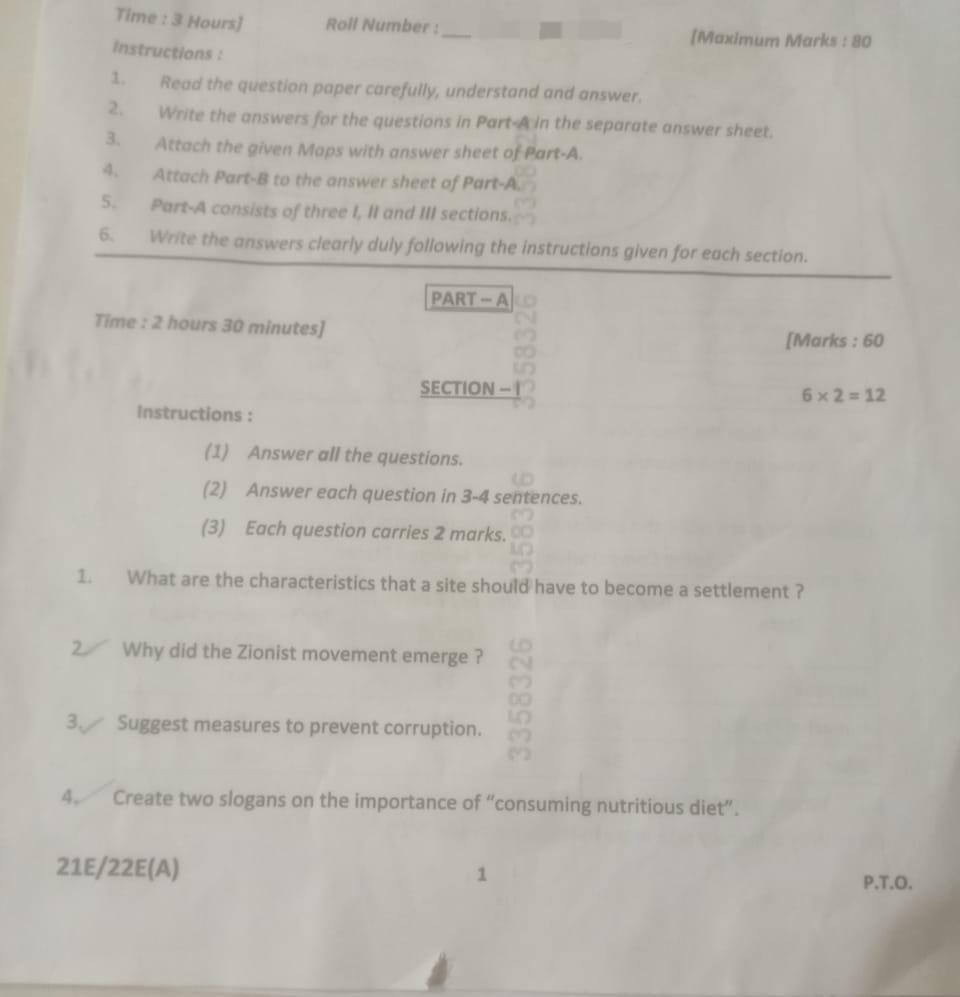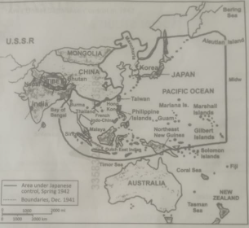TS Class 10 Social Studies Question Paper And Answer Key 2025: The Telangana Board conducted the Class 10th Social Studies exam today for the academic year 2024-25. The test took place during the morning shift. The 10th Social Studies question paper and answer key are now available to exam takers in PDF format. Before the official results are out, this will assist students in evaluating their performance and estimating their scores.
TS Class 10 Social Studies 2025: Exam Analysis
The exam is over and experts have provided a detailed analysis of the 10th Social Studies paper, covering aspects like:
Student Review:
- Moderate to Difficult Paper – Many students found the exam slightly challenging, especially sections related to Genetics and Biotechnology.
- Lengthy but Manageable – While the paper covered all key topics, some students struggled with time management due to long-answer questions.
Teacher Review:
- Concept-Oriented Paper – Teachers appreciated the focus on conceptual understanding rather than rote memorization, especially in Ecology and Human Physiology.
- Source-Based Questions – The exam included a fair mix of direct and case-based questions, testing students' analytical skills effectively.
TS Class 10 Social Studies Question paper 2025: Exam Pattern
The assessment Scheme for TS Class 10 Social Studies 2025 will be as follows:
| Theory Paper | 80 marks |
| Practical | 20 Marks |
| Total | 100 Marks |
TS Class 10 Social Studies: Question Paper 2025
Students can check class 10 PSEB Social Studies Question Paper Here.

TS Class 10 Social Studies Question Paper 2025: Download PDF
TS Class 10 Social Studies: Answer Key 2025
Now that the paper is over, students might be waiting for the answer key. The answer key helps the students to estimate their total score. Students can check the link to the answer key.
Part A - Section I
1. What are the characteristics that a site should have to become a settlement?
A site should have the following characteristics to become a settlement:
-
Availability of Water: A nearby water source like a river or lake is essential for drinking, irrigation, and daily activities.
-
Fertile Land: The land should be suitable for agriculture to support food production.
-
Favorable Climate: Moderate temperatures and good weather conditions make a site livable.
-
Transport and Connectivity: Easy access to roads, rivers, or railways helps in trade and communication.
-
Security: A settlement should be safe from natural disasters, enemy attacks, and other threats.
2. Why did the Zionist movement emerge?
The Zionist movement emerged in the late 19th century due to the following reasons:
-
Oppression of Jews: Jews faced discrimination and persecution in many parts of Europe and Russia.
-
Desire for a Homeland: The movement aimed to establish a Jewish homeland in Palestine, where Jews had historical and religious connections.
-
Rise of Nationalism: Inspired by other nationalist movements, Jews sought to reclaim their identity and self-governance.
-
Dreyfus Affair: Events like the wrongful conviction of Jewish officer Alfred Dreyfus in France fueled Zionist aspirations.
-
Leadership of Theodor Herzl: He advocated for the establishment of a Jewish state and mobilized support.
3. Suggest measures to prevent corruption.
To prevent corruption, the following measures can be taken:
-
Strict Laws and Enforcement: Strong anti-corruption laws and strict punishments should be implemented.
-
Transparency in Governance: Public officials should disclose assets and decisions should be made openly.
-
Use of Technology: Digital transactions and e-governance can reduce bribery and fraud.
-
Public Awareness: Educating citizens about their rights and encouraging whistleblowing can help combat corruption.
-
Strong Institutions: Independent bodies like anti-corruption commissions should monitor and act against corrupt practices.
4. Create two slogans on the importance of "consuming a nutritious diet."
-
"Eat healthy, stay strong – Nutrition keeps you going long!"
-
"A balanced diet every day, keeps diseases far away!"
Question 5

(a) What does the map show?
The map shows the extent of Japanese control in Asia and the Pacific region during World War II. It highlights areas occupied by Japan by December 1941 and further expansion by spring 1942.
(b) Name the two countries that were out of Japanese control.
The two countries that were out of Japanese control were:
-
India
-
U.S.S.R (Soviet Union)
Question 6
| State | IMR per 1000 (2016) | Literacy Rate (%) (2011) | Net Attendance Ratio for Secondary Stage (2013-14) |
| Haryana | 33 | 77 | 61 |
| Himachal Pradesh | 25 | 84 | 67 |
| Bihar | 38 | 64 | 43 |
(a) Which state has the lowest IMR?
IMR (Infant Mortality Rate) per 1000 in 2016:
-
Haryana: 33
-
Himachal Pradesh: 25
-
Bihar: 38
The state with the lowest IMR is Himachal Pradesh (25 per 1000).
(b) Why is the literacy rate higher in Himachal Pradesh?
The literacy rate is higher in Himachal Pradesh due to the following reasons:
-
Better Educational Infrastructure: The state has well-established schools and government initiatives promoting education.
-
Higher Awareness: People in Himachal Pradesh give more importance to education, especially in rural areas.
-
Government Schemes: Various state-sponsored programs encourage primary and secondary education.
-
Higher Net Attendance Ratio: The data shows that Himachal Pradesh has a 67% attendance ratio, higher than Haryana (61%) and Bihar (43%), indicating more students complete secondary education.
SECTION – II
7. What were the consequences of the partition of India?
The partition of India in 1947 had several major consequences:
-
Mass Migration: Around 10-15 million people migrated between India and Pakistan, leading to chaos and violence.
-
Communal Riots: Widespread killings, loot, and destruction occurred between Hindus, Muslims, and Sikhs.
-
Refugee Crisis: Millions were left homeless and had to rebuild their lives from scratch.
-
Division of Resources: India and Pakistan had to divide financial and military assets, creating tensions.
-
Political Impact: The event shaped the political landscape, leading to long-term conflicts between the two nations, including wars.
8. What is meant by population change? What are the factors affecting population change?
Population change refers to the increase or decrease in the number of people in a region over time. It is influenced by several factors:
-
Birth Rate: Higher birth rates lead to population growth.
-
Death Rate: A decrease in death rates due to medical advancements increases population.
-
Migration: Movement of people in and out of a country affects population size.
-
Government Policies: Policies like China’s one-child policy or incentives for large families impact the population.
-
Natural Disasters and Wars: These can cause sudden decreases in population.
9. Prepare a pamphlet on the importance of 'Casting the Vote' to make people aware.
YOUR VOTE, YOUR VOICE!
Why Vote?
-
Strengthens democracy and ensures fair governance.
-
Helps in electing responsible leaders.
-
Shapes the future of the country.
Who Can Vote?
-
Any citizen above 18 years of age.
-
Must have a valid Voter ID card.
How to Vote?
-
Check your name in the voter list.
-
Go to the polling booth with your ID.
-
Cast your vote through EVM or ballot.
Be a responsible citizen – Vote for a better future!
11. Read the given paragraph and interpret.
The paragraph discusses the conflict between developed and developing nations regarding environmental policies:
-
Developed countries want to cut down on coal and fossil fuel use to reduce greenhouse gases.
-
Developing countries argue that developed nations used fossil fuels for their growth, and now it’s their turn.
-
This creates a dilemma between environmental protection and economic growth.
-
A balanced approach with clean energy alternatives and fair policies is needed to resolve this issue.
12. Observe the given table and analyze.
Total Cropped Area (in Million Hectares)
| Region | 1955-56 | 2006-07 | Growth % |
| Andhra Region | 4.2 | 5.3 | 20% |
| Telangana Region | 4.8 | 5.0 | 5% |
Analysis:
-
The Andhra Region saw higher growth (20%) in cropped area, indicating better irrigation, agricultural practices, or government support.
-
The Telangana Region experienced only 5% growth, suggesting challenges such as land availability, water shortages, or urbanization.
-
The data shows an overall increase in agricultural land use, which may impact food production and economy.
SECTION – III
13. Explain the impact of Globalization on India.
Globalization has had significant effects on India:
-
Economic Growth: Increased foreign investment and rapid industrialization boosted India's economy.
-
Job Opportunities: IT, manufacturing, and service sectors expanded, creating employment.
-
Cultural Exchange: Western influence on fashion, food, and lifestyle became prominent.
-
Technology & Innovation: India became a global hub for software development and startups.
-
Challenges: Small businesses face competition from global companies, and income inequality has widened.
14. State the reasons why land reforms are not implemented in the country even today and give suitable suggestions for proper implementation.
Reasons for Non-Implementation:
-
Lack of Political Will: Powerful landowners influence policies to prevent reforms.
-
Corruption: Bureaucratic hurdles slow down the process.
-
Poor Land Records: Inaccurate data leads to disputes and delays.
-
Resistance from Landowners: Large landlords oppose redistribution policies.
Suggestions for Implementation:
-
Digitization of Land Records: Ensuring transparency in ownership and transactions.
-
Strict Laws & Policies: Enforcing land ceiling laws to prevent hoarding.
-
Awareness Campaigns: Educating farmers on their rights and benefits.
Government Support: Providing financial aid for land redistribution programs.
Also Check:
Comments
All Comments (0)
Join the conversation